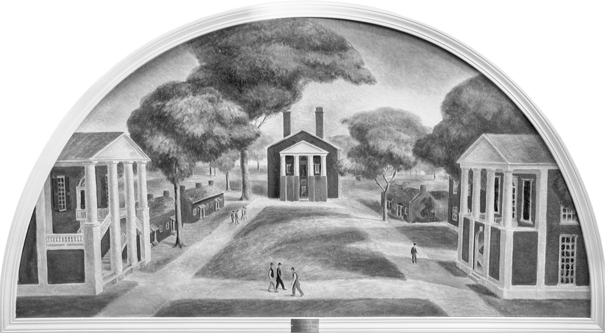Baker, Archibald
10 Dec. 1812–2 Oct. 1878
 Archibald Baker, minister and educator, was born in Marion County, S.C. At an early age, he moved with his parents, Archibald (1769–1842) and Catherine McCallum Baker (1777–1859), to Robeson County, where he grew up. He attended Jackson College, Columbia, Tenn., and in 1837 enrolled in Union Theological Seminary, Richmond, Va. Following his graduation, he was licensed by the Fayetteville presbytery on 17 Oct. 1840.
Archibald Baker, minister and educator, was born in Marion County, S.C. At an early age, he moved with his parents, Archibald (1769–1842) and Catherine McCallum Baker (1777–1859), to Robeson County, where he grew up. He attended Jackson College, Columbia, Tenn., and in 1837 enrolled in Union Theological Seminary, Richmond, Va. Following his graduation, he was licensed by the Fayetteville presbytery on 17 Oct. 1840.
Ordained by the same presbytery on 15 May 1841, he began his career as a Presbyterian minister at the church in Laurel Hill. From 1841 until 1845 he served the churches on the Ashpole circuit as well as his own. In 1848 he became pastor of the church in Salisbury, which added 156 communicants to its roll during his eleven years there.
While in Salisbury, he took an active part in the affairs of the North Carolina Synod. He chaired the committee on colportage in 1849 and 1858 and served on the committee on devotional exercises in 1852 and 1857. Elected moderator in 1851, he preached his valedictory sermon in 1852 on Psalm 48. In 1852, the synod named Baker its first agent for foreign missions, a post he held for seven years. In 1855 he succeeded Drury Lacy as stated clerk of the synod.
Baker's paramount interest was education, particularly higher education. Elected to the Synodical Board of Education in 1848, he served as its secretary in 1850. He represented the synod on the board of directors of Union Theological Seminary and was chosen second vice-president of the board in 1854. The Salisbury Academy, sponsored by his church, achieved a state-wide reputation for excellence under the guidance of Baker and its board of trustees, which included Maxwell Chambers. Chambers, whose wife, Catherine, was a member of Baker's congregation, shared another interest with Baker: Davidson, the college established by the synod in 1835. Baker addressed the fledgling college's literary societies in 1845 and conducted the sale of Davidson scholarships in Concord presbytery. Chambers, a member of the building committee, loaned $5,000 to the hard-pressed institution in 1852.
When he died, Chambers left substantial sums to every member of Baker's family and his library to Baker himself. He bequeathed the bulk of his estate, over $250,000, to Davidson. This gift, which put the college on firm financial footing, has been attributed to Baker's advice and influence. In 1858, Davidson's trustees placed a history of the college, written by Baker at their request, and a copy of Chambers's will in the cornerstone of the first building erected with the endowment.
One year later, Baker left North Carolina for a church in Fernandina, Fla. In 1873 he returned to assume the presidency of Floral College and a pastorate at Centre Church in Robeson County. After more than three years' service, he resigned the presidency but continued as Centre's minister and a leader in the synod Sunday School Association. While addressing an association convention, held in his church, he was stricken by paralysis and died.
Baker and his first wife, Sarah James (d. 1856), had five children: Hinton J., Catherine, Laura, Archibald Hinton, and Annie. In 1861, Baker married Mary Elizabeth Gilchrist (1832–1904).
Several reference sources provide conflicting birth dates.
References:
Last Will of Maxwell Chambers (North Carolina Collection, University of North Carolina, Chapel Hill).
Presbyterian Church in the U.S., Minutes of the Sessions, North Carolina Synod.
Jethro Rumple, The History of Presbyterianism in North Carolina (1966), and A History of Rowan County (1881).
E. C. Scott, comp., Ministerial Directory of the Presbyterian Church, U.S. (1942).
Additional Resources:
"Enter into his gates" : history of the First Presbyterian Church, Maxton, North Carolina, 1878-1958. LaMotte, Edward M. East Carolina Digital Collections: https://digital.lib.ecu.edu/17008
Presbyterian Church in the U.S. Synod of North Carolina. Meeting. Minutes of the ... annual sessions of the Synod of North Carolina ... [serial]. [North Carolina : The Synod. 1983. https://archive.org/details/minutesofannuals75pres (accessed February 20, 2013).
Image Credits:
An oil painting by Kentucky muralist Frank Long depicts the original quadrangle at Davidson College as it looked during the second half of the nineteenth century. Photograph courtesy of Davidson College. From the Encyclopedia of North Carolina entry on Davidson College, UNC Press.
1 January 1979 | Neal, Ellen Barrier